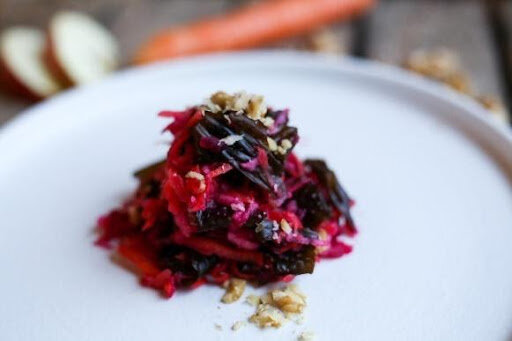EATE Spotlight - Lofoten Seaweed Company
Tamara and Angelita harvesting seaweed on the shores of Lofoten.
Delicious, sustainable and packed with nutrients, seaweed is fast becoming a favourite with chefs and cooks all over the world. Seaweed is a traditional ingredient in Japanese cuisine and is largely undiscovered in the kitchens of the west. There are many different types of seaweed, all offering different flavours, textures and nutrients - the possibilities for any curious cook are limitless.
Seaweed drying in the rorbu
Located in amongst the fishing boats in a small village on the Lofoten Islands, an arctic archipelago 1000km north of Oslo, is a wooden rorbu, or fishing cabin. The cabin is home to Lofoten Seaweed, a company founded by best friends Angelita and Tamara, and is where the freshly wild-harvested seaweed is dried and stored after being hand picked from the nearby coast.
Angelita is the daughter of a fisherman and grew up in Lofoten: baiting long lines and cutting cod tongues. Tamara grew up in New Zealand, where she was fed seaweed at almost every meal by her Japanese mother. Tamara and Angelita met while studying Australia and, bonded by their love of the ocean and food, quickly became best friends.
Tamara and Angelita harvesting seaweed with the glorious backdrop of the mountains of the Lofoten islands.
Angelita and Tamara started Lofoten Seaweed in 2017, which continues to grow and expand. This year, they won the Entrepreneur of the Year Award in Norway. In Norway, as in the UK and Europe, seaweed is a relatively undiscovered ingredient. Angelita and Tamara aim to create easy to use and versatile products, like Seaweed Salts, that everyone can cook with, as well as supplying chefs and restaurants with hand-harvested seaweed.
The arctic waters surrounding Lofoten are a seaweed paradise. Seaweed loves cold water – absorbing more nutrients and reproducing faster than in warmer climates. The strong tidal currents around the archipelago constantly bring fresh, nutrient-rich water to shore – fertilising the wild-growing seaweed.
Harvest season in the Lofoten Islands.
These waters are also among the purest in the world. The clean coastal environment encourages a thriving marine life – including the world’s largest deep-water coral reef. As seaweed absorbs nutrients from the sea, the clean, nutrient-rich ocean around Lofoten produces seaweed packed full of vitamins, minerals, and flavour.
The Lofoten Islands are the world’s biggest spawning ground for Atlantic cod, which make the long journey every winter from the Barents Sea. Fishing has been the lifeline for inhabitants of the islands for centuries and remains the main source of income for many today.
For the locals in a rural island community which has always depended on the ocean for food and livelihood, food traditions flourish and the island’s inhabitants are keen to preserve their connection to the sea.
Seaweed has been eaten in Japan for thousands of years. Traditionally used for preparing dashi broths, as well as being added to salads, soups and wrapping sushi rolls, seaweed remains a staple ingredient in Japanese cooking today.
Seaweed arancini
For an island nation like Japan, different species of seaweed grow in large quantities on the coast, making it an accessible and fresh source of food. As each type of seaweed has a different flavour - from the earthy taste of truffle seaweed, to the sweetness of sugar kelp, and the mildly nutty taste of butare - seaweed works well in other cuisines too, not just Japanese. Cooking with seaweed is all about getting creative, thinking outside the box and using the natural flavour to enhance dishes; adding colour, taste and texture.
Aside from its availability on the shores of Japan, perhaps seaweed has remained such an important part of Japanese cuisine due to it’s incredible health-giving properties. Low levels of breast cancers in Japan has been linked by various studies to the consumption of seaweed. Seaweed is packed full of nutrients and is an excellent source of vitamins and minerals, including iodine, iron and magnesium. The polysaccharides found in seaweed also act as a prebiotic fibre for healthy gut flora and antiviral properties may even help to stave off colds and flu.
Winged kelp, beetroot and apple salad.
As concerns about the impact of the food industry on the environment grows, finding sustainably produced food is becoming more and more important for chefs, as well as home cooks.
Scientists have repeatedly warned against the disastrous effect our current food systems are having on the planet – citing agriculture as one of the biggest contributors to pollution, ecological degradation and climate change.
Seaweed has the potential to address these issues, mitigating environmental damage and cutting marine pollution. Seaweed actually has a positive impact on the natural world, sequestering toxins such as phosphorus and carbon from the ocean – which is a main contributor towards climate change. Also, unlike other crops, seaweed flourishes in the wild and requires no land, freshwater or chemical fertilizers.
As with any natural resource, however, we have a responsibility to care for the seaweed we harvest.
Lofoten Seaweed collects data on the growing behaviour of seaweed in their harvesting locations, using this to inform where, when and what they harvest. Sustainable harvesting practices like this ensure that the seaweed will continue to flourish into the future.
Seaweed has been hailed as the ‘food of the future’, with the United Nations releasing a Seaweed Manifesto and British supermarket Waitrose reporting a 141% increase in online searches for seaweed. Whether it be for environmental, culinary, or novelty reasons, the surge in interest for Seaweed in the western world is an exciting prospect. With companies like Lofoten leading the way in sustainable seaweed cultivation, this seaweed revolution looks set to flourish.
To find out more about Lofoten Seaweed, visit www.lofotenseaweed.com.
Instagram: @lofotenseaweed
Contact Lofoten Seaweed here.






